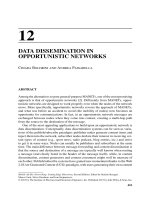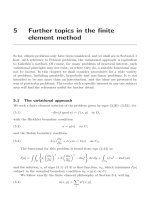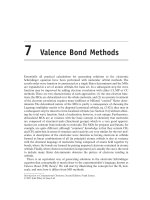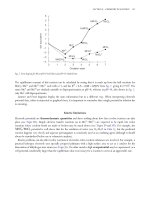Ebook Starting out with python (2nd edition) Part 2
Bạn đang xem bản rút gọn của tài liệu. Xem và tải ngay bản đầy đủ của tài liệu tại đây (4.76 MB, 319 trang )
CHAPTER
8
Lists and Tuples
TOPICS
8.1
8.2
8.3
8.4
8.5
8.1
Sequences
Introduction to Lists
List Slicing
Finding Items in Lists with the in Operator
List Methods and Useful Built-in Functions
8.6
8.7
8.8
8.9
Copying Lists
Processing Lists
Two-Dimensional Lists
Tuples
Sequences
CONCEPT: A sequence is an object that holds multiple items of data, stored one
after the other. You can perform operations on a sequence to examine
and manipulate the items stored in it.
A sequence is an object that contains multiple items of data. The items that are in a
sequence are stored one after the other. Python provides various ways to perform operations on the items that are stored in a sequence.
There are several different types of sequence objects in Python. In this chapter we will look
at two of the fundamental sequence types: lists and tuples. Both lists and tuples are
sequences that can hold various types of data. The difference between lists and tuples is simple: a list is mutable, which means that a program can change its contents, but a tuple is
immutable, which means that once it is created, its contents cannot be changed. We will
explore some of the operations that you may perform on these sequences, including ways
to access and manipulate their contents.
8.2
Introduction to Lists
CONCEPT: A list is an object that contains multiple data items. Lists are mutable,
which means that their contents can be changed during a program’s
execution. Lists are dynamic data structures, meaning that items may be
added to them or removed from them. You can use indexing, slicing, and
various methods to work with lists in a program.
295
296
Chapter 8
Lists and Tuples
A list is an object that contains multiple data items. Each item that is stored in a list is called
an element. Here is a statement that creates a list of integers:
even_numbers = [2, 4, 6, 8, 10]
The items that are enclosed in brackets and separated by commas are the list elements. After
this statement executes, the variable even_numbers will reference the list, as shown in
Figure 8-1.
Figure 8-1
A list of integers
2
even_numbers
4
6
8
10
The following is another example:
names = ['Molly', 'Steven', 'Will', 'Alicia', 'Adriana']
This statement creates a list of five strings. After the statement executes, the name variable
will reference the list as shown in Figure 8-2.
Figure 8-2
A list of strings
names
Molly
Steven
Will
Alicia
Adriana
A list can hold items of different types, as shown in the following example:
info = ['Alicia', 27, 1550.87]
This statement creates a list containing a string, an integer, and a floating-point number. After
the statement executes, the info variable will reference the list as shown in Figure 8-3.
Figure 8-3
A list holding different types
info
Alicia
27
1550.87
You can use the print function to display an entire list, as shown here:
numbers = [5, 10, 15, 20]
print(numbers)
In this example, the print function will display the elements of the list like this:
[5, 10, 15, 20]
Python also has a built-in list() function that can convert certain types of objects to lists.
For example, recall from Chapter 5 that the range function returns an iterable, which is an
object that holds a series of values that can be iterated over. You can use a statement such
as the following to convert the range function’s iterable object to a list:
numbers = list(range(5))
8.2 Introduction to Lists
When this statement executes, the following things happen:
• The range function is called with 5 passed as an argument. The function returns an
iterable containing the values 0, 1, 2, 3, 4.
• The iterable is passed as an argument to the list() function. The list() function
returns the list [0, 1, 2, 3, 4].
• The list [0, 1, 2, 3, 4] is assigned to the numbers variable.
Here is another example:
numbers = list(range(1, 10, 2))
Recall from Chapter 5 that when you pass three arguments to the range function, the
first argument is the starting value, the second argument is the ending limit, and the third
argument is the step value. This statement will assign the list [1, 3, 5, 7, 9] to the
numbers variable.
The Repetition Operator
You learned in Chapter 2 that the * symbol multiplies two numbers. However, when the
operand on the left side of the * symbol is a sequence (such as a list) and the operand on
the right side is an integer, it becomes the repetition operator. The repetition operator
makes multiple copies of a list and joins them all together. Here is the general format:
list * n
In the general format, list is a list and n is the number of copies to make. The following
interactive session demonstrates:
1
2
3
4
>>> numbers = [0] * 5 e
>>> print(numbers) e
[0, 0, 0, 0, 0]
>>>
Let’s take a closer look at each statement:
• In line 1 the expression [0] * 5 makes five copies of the list [0] and joins them all
together in a single list. The resulting list is assigned to the numbers variable.
• In line 2 the numbers variable is passed to the print function. The function’s output
is shown in line 3.
Here is another interactive mode demonstration:
1
2
3
4
>>> numbers = [1, 2, 3] * 3 e
>>> print(numbers) e
[1, 2, 3, 1, 2, 3, 1, 2, 3]
>>>
N O T E : Most programming languages allow you to create sequence structures
known as arrays, which are similar to lists, but are much more limited in their capabilities. You cannot create traditional arrays in Python because lists serve the same purpose and provide many more built-in capabilities.
297
298
Chapter 8
Lists and Tuples
Iterating over a List with the for Loop
In Section 8.1 we discussed techniques for accessing the individual characters in a string.
Many of the same programming techniques also apply to lists. For example, you can iterate over a list with the for loop, as shown here:
numbers = [99, 100, 101, 102]
for n in numbers:
print(n)
If we run this code, it will print:
99
100
101
102
Indexing
Another way that you can access the individual elements in a list is with an index. Each element in a list has an index that specifies its position in the list. Indexing starts at 0, so the
index of the first element is 0, the index of the second element is 1, and so forth. The index
of the last element in a list is 1 less than the number of elements in the list.
For example, the following statement creates a list with 4 elements:
my_list = [10, 20, 30, 40]
The indexes of the elements in this list are 0, 1, 2, and 3. We can print the elements of the
list with the following statement:
print(my_list[0], my_list[1], my_list[2], my_list[3])
The following loop also prints the elements of the list:
index = 0
while index < 4:
print(my_list[index])
index += 1
You can also use negative indexes with lists, to identify element positions relative to the end
of the list. The Python interpreter adds negative indexes to the length of the list to determine the element position. The index Ϫ1 identifies the last element in a list, Ϫ2 identifies
the next to last element, and so forth. The following code shows an example:
my_list = [10, 20, 30, 40]
print(my_list[-1], my_list[-2], my_list[-3], my_list[-4])
In this example, the print function will display:
40 30 20 10
An IndexError exception will be raised if you use an invalid index with a list. For example, look at the following code:
# This code will cause an IndexError exception.
my_list = [10, 20, 30, 40]
8.2 Introduction to Lists
index = 0
while index < 5:
print(my_list[index])
index += 1
The last time that this loop iterates, the index variable will be assigned the value 5, which
is an invalid index for the list. As a result, the statement that calls the print function will
cause an IndexError exception to be raised.
The len Function
Python has a built-in function named len that returns the length of a sequence, such as a
list. The following code demonstrates:
my_list = [10, 20, 30, 40]
size = len(my_list)
The first statement assigns the list [10, 20, 30, 40] to the my_list variable. The second statement calls the len function, passing the my_list variable as an argument.
The function returns the value 4, which is the number of elements in the list. This value is
assigned to the size variable.
The len function can be used to prevent an IndexError exception when iterating over a
list with a loop. Here is an example:
my_list = [10, 20, 30, 40]
index = 0
while index < len(my_list):
print(my_list[index])
index += 1
Lists Are Mutable
Lists in Python are mutable, which means their elements can be changed. Consequently, an
expression in the form list[index] can appear on the left side of an assignment operator.
The following code shows an example:
1
2
3
4
numbers = [1, 2, 3, 4, 5]
print(numbers)
numbers[0] = 99
print(numbers)
The statement in line 2 will display
[1, 2, 3, 4, 5]
The statement in line 3 assigns 99 to numbers[0]. This changes the first value in the list to
99. When the statement in line 4 executes, it will display
[99, 2, 3, 4, 5]
When you use an indexing expression to assign a value to a list element, you must use a
valid index for an existing element or an IndexError exception will occur. For example,
299
300
Chapter 8
Lists and Tuples
look at the following code:
numbers = [1, 2, 3, 4, 5]
numbers[5] = 99
# Create a list with 5 elements.
# This raises an exception!
The numbers list that is created in the first statement has five elements, with the indexes 0
through 4. The second statement will raise an IndexError exception because the numbers
list has no element at index 5.
If you want to use indexing expressions to fill a list with values, you have to create the list
first, as shown here:
1
2
3
4
5
6
7
8
# Create a list with 5 elements.
numbers = [0] * 5
# Fill the list with the value 99.
index = 0
while index < len(numbers):
numbers[index] = 99
index += 1
The statement in line 2 creates a list with five elements, each element assigned the value 0.
The loop in lines 6 through 8 then steps through the list elements, assigning 99 to each one.
Program 8-1 shows an example of how user input can be assigned to the elements of a list.
This program gets sales amounts from the user and assigns them to a list.
Program 8-1
1
2
3
4
5
6
7
8
9
10
11
12
13
14
15
16
17
18
19
20
(sales_list.py)
# The NUM_DAYS constant holds the number of
# days that we will gather sales data for.
NUM_DAYS = 5
def main():
# Create a list to hold the sales
# for each day.
sales = [0] * NUM_DAYS
# Create a variable to hold an index.
index = 0
print('Enter the sales for each day.')
# Get the sales for each day.
while index < NUM_DAYS:
print('Day #', index + 1, ': ', sep='', end='')
sales[index] = float(input())
index += 1
8.2 Introduction to Lists
21
# Display the values entered.
22
print('Here are the values you entered:')
23
for value in sales:
24
print(value)
25
26 # Call the main function.
27 main()
Program Output (with input shown in bold)
Enter the sales for each day.
Day #1: 1000 e
Day #2: 2000 e
Day #3: 3000 e
Day #4: 4000 e
Day #5: 5000 e
Here are the values you entered:
1000.0
2000.0
3000.0
4000.0
5000.0
The statement in line 3 creates the variable NUM_DAYS, which is used as a constant for the
number of days. The statement in line 8 creates a list with five elements, with each element
assigned the value 0. Line 11 creates a variable named index and assigns the value 0 to it.
The loop in lines 16 through 19 iterates 5 times. The first time it iterates, index references the
value 0, so the statement in line 18 assigns the user’s input to sales[0]. The second time the
loop iterates, index references the value 1, so the statement in line 18 assigns the user’s input
to sales[1]. This continues until input values have been assigned to all the elements in the list.
Concatenating Lists
To concatenate means to join two things together. You can use the + operator to concatenate two lists. Here is an example:
list1 = [1, 2, 3, 4]
list2 = [5, 6, 7, 8]
list3 = list1 + list2
After this code executes, list1 and list2 remain unchanged, and list3 references the following list:
[1, 2, 3, 4, 5, 6, 7, 8]
The following interactive mode session also demonstrates list concatenation:
>>> girl_names = ['Joanne', 'Karen', 'Lori'] e
>>> boy_names = ['Chris', 'Jerry', 'Will'] e
>>> all_names = girl_names + boy_names e
301
302
Chapter 8
Lists and Tuples
>>> print(all_names) e
['Joanne', 'Karen', 'Lori', 'Chris', 'Jerry', 'Will']
You can also use the += augmented assignment operator to concatenate one list to another.
Here is an example:
list1 = [1, 2, 3, 4]
list2 = [5, 6, 7, 8]
list1 += list2
The last statement appends list2 to list1. After this code executes, list2 remains
unchanged, but list1 references the following list:
[1, 2, 3, 4, 5, 6, 7, 8]
The following interactive mode session also demonstrates the += operator used for list concatenation:
>>> girl_names = ['Joanne', 'Karen', 'Lori'] e
>>> girl_names += ['Jenny', 'Kelly'] e
>>> print(girl_names) e
['Joanne', 'Karen', 'Lori', 'Jenny', 'Kelly']
>>>
N O T E : Keep in mind that you can concatenate lists only with other lists. If you try
to concatenate a list with something that is not a list, an exception will be raised.
Checkpoint
8.1
What will the following code display?
numbers = [1, 2, 3, 4, 5]
numbers[2] = 99
print(numbers)
8.2
What will the following code display?
numbers = list(range(3))
print(numbers)
8.3
What will the following code display?
numbers = [10] * 5
print(numbers)
8.4
What will the following code display?
numbers = list(range(1, 10, 2))
for n in numbers:
print(n)
8.5
What will the following code display?
numbers = [1, 2, 3, 4, 5]
print(numbers[-2])
8.6
How do you find the number of elements in a list?
8.3 List Slicing
8.7
What will the following code display?
numbers1 = [1, 2, 3]
numbers2 = [10, 20, 30]
numbers3 = numbers1 + numbers2
print(numbers1)
print(numbers2)
print(numbers3)
8.8
What will the following code display?
numbers1 = [1, 2, 3]
numbers2 = [10, 20, 30]
numbers2 += numbers1
print(numbers1)
print(numbers2)
8.3
List Slicing
CONCEPT: A slicing expression selects a range of elements from a sequences
You have seen how indexing allows you to select a specific element in a sequence.
Sometimes you want to select more than one element from a sequence. In Python, you can
write expressions that select subsections of a sequence, known as slices.
VideoNote
List Slicing
A slice is a span of items that are taken from a sequence. When you take a slice from a list,
you get a span of elements from within the list. To get a slice of a list, you write an expression in the following general format:
list_name[start : end]
In the general format, start is the index of the first element in the slice, and end is the index
marking the end of the slice. The expression returns a list containing a copy of the elements
from start up to (but not including) end. For example, suppose we create the following list:
days = ['Sunday', 'Monday', 'Tuesday', 'Wednesday',
'Thursday', 'Friday', 'Saturday']
The following statement uses a slicing expression to get the elements from indexes 2 up to,
but not including, 5:
mid_days = days[2:5]
After this statement executes, the mid_days variable references the following list:
['Tuesday', 'Wednesday', 'Thursday']
You can quickly use the interactive mode interpreter to see how slicing works. For example, look at the following session. (We have added line numbers for easier reference.)
1
2
3
>>> numbers = [1, 2, 3, 4, 5] e
>>> print(numbers) e
[1, 2, 3, 4, 5]
303
304
Chapter 8
Lists and Tuples
4 >>> print(numbers[1:3]) e
5 [2, 3]
6 >>>
Here is a summary of each line:
• In line 1 we created the list and [1, 2, 3, 4, 5] and assigned it to the numbers
variable.
• In line 2 we passed numbers as an argument to the print function. The print function displayed the list in line 3.
• In line 4 we sent the slice numbers[1:3] as an argument to the print function. The
print function displayed the slice in line 5.
If you leave out the start index in a slicing expression, Python uses 0 as the starting index.
The following interactive mode session shows an example:
1
2
3
4
5
6
>>>
>>>
[1,
>>>
[1,
>>>
numbers = [1, 2, 3, 4, 5] e
print(numbers) e
2, 3, 4, 5]
print(numbers[:3]) e
2, 3]
Notice that line 4 sends the slice numbers[:3] as an argument to the print function. Because
the starting index was omitted, the slice contains the elements from index 0 up to 3.
If you leave out the end index in a slicing expression, Python uses the length of the list as
the end index. The following interactive mode session shows an example:
1
2
3
4
5
6
>>>
>>>
[1,
>>>
[3,
>>>
numbers = [1, 2, 3, 4, 5] e
print(numbers) e
2, 3, 4, 5]
print(numbers[2:]) e
4, 5]
Notice that line 4 sends the slice numbers[2:] as an argument to the print function.
Because the ending index was omitted, the slice contains the elements from index 2 through
the end of the list.
If you leave out both the start and end index in a slicing expression, you get a copy of the
entire list. The following interactive mode session shows an example:
1
2
3
4
5
6
>>>
>>>
[1,
>>>
[1,
>>>
numbers = [1, 2, 3, 4, 5] e
print(numbers) e
2, 3, 4, 5]
print(numbers[:]) e
2, 3, 4, 5]
The slicing examples we have seen so far get slices of consecutive elements from lists. Slicing
expressions can also have step value, which can cause elements to be skipped in the list. The
following interactive mode session shows an example of a slicing expression with a step
value:
8.3 List Slicing
1
2
3
4
5
6
>>>
>>>
[1,
>>>
[2,
>>>
numbers = [1, 2, 3, 4, 5, 6, 7, 8, 9, 10] e
print(numbers) e
2, 3, 4, 5, 6, 7, 8, 9, 10]
print(numbers[1:8:2]) e
4, 6, 8]
In the slicing expression in line 4, the third number inside the brackets is the step value. A
step value of 2, as used in this example, causes the slice to contain every second element
from the specified range in the list.
You can also use negative numbers as indexes in slicing expressions to reference positions relative to the end of the list. Python adds a negative index to the length of a list to get the position referenced by that index. The following interactive mode session shows an example:
1
2
3
4
5
6
>>>
>>>
[1,
>>>
[6,
>>>
numbers = [1, 2, 3, 4, 5, 6, 7, 8, 9, 10] e
print(numbers) e
2, 3, 4, 5, 6, 7, 8, 9, 10]
print(numbers[-5:]) e
7, 8, 9, 10]
N 0 T E : Invalid indexes do not cause slicing expressions to raise an exception. For
example:
• If the end index specifies a position beyond the end of the list, Python will use the
length of the list instead.
• If the start index specifies a position before the beginning of the list, Python will
use 0 instead.
• If the start index is greater than the end index, the slicing expression will return an
empty list.
Checkpoint
8.9
What will the following code display?
numbers = [1, 2, 3, 4, 5]
my_list = numbers[1:3]
print(my_list)
8.10 What will the following code display?
numbers = [1, 2, 3, 4, 5]
my_list = numbers[1:]
print(my_list)
8.11 What will the following code display?
numbers = [1, 2, 3, 4, 5]
my_list = numbers[:1]
print(my_list)
305
306
Chapter 8
Lists and Tuples
8.12 What will the following code display?
numbers = [1, 2, 3, 4, 5]
my_list = numbers[:]
print(my_list)
8.13 What will the following code display?
numbers = [1, 2, 3, 4, 5]
my_list = numbers[-3:]
print(my_list)
8.4
Finding Items in Lists with the in Operator
CONCEPT: You can search for an item in a list using the in operator.
In Python you can use the in operator to determine whether an item is contained in a list.
Here is the general format of an expression written with the in operator to search for an
item in a list:
item in list
In the general format, item is the item for which you are searching, and list is a list. The
expression returns true if item is found in the list or false otherwise. Program 8-2 shows
an example.
Program 8-2
1
2
3
4
5
6
7
8
9
10
11
12
13
14
15
16
17
18
(in_list.py)
# This program demonstrates the in operator
# used with a list.
def main():
# Create a list of product numbers.
prod_nums = ['V475', 'F987', 'Q143', 'R688']
# Get a product number to search for.
search = input('Enter a product number: ')
# Determine whether the product number is in the list.
if search in prod_nums:
print(search, 'was found in the list.')
else:
print(search, 'was not found in the list.')
# Call the main function.
main()
8.5 List Methods and Useful Built-in Functions
Program Output (with input shown in bold)
Enter a product number: Q143 e
Q143 was found in the list.
Program Output (with input shown in bold)
Enter a product number: B000 e
B000 was not found in the list.
The program gets a product number from the user in line 9 and assigns it to the search
variable. The if statement in line 12 determines whether search is in the prod_nums list.
You can use the not in operator to determine whether an item is not in a list. Here is an
example:
if search not in prod_nums:
print(search, 'was not found in the list.')
else:
print(search, 'was found in the list.')
Checkpoint
8.14 What will the following code display?
names = ['Jim', 'Jill', 'John', 'Jasmine']
if 'Jasmine' not in names:
print('Cannot find Jasmine.')
else:
print("Jasmine's family:")
print(names)
8.5
List Methods and Useful Built-in Functions
CONCEPT: Lists have numerous methods that allow you to work with the elements
that they contain. Python also provides some built-in functions that are
useful for working with lists.
Lists have numerous methods that allow you to add elements, remove elements, change the
ordering of elements, and so forth. We will look at a few of these methods,1 which are listed
in Table 8-1.
The append Method
The append method is commonly used to add items to a list. The item that is passed as an
argument is appended to the end of the list’s existing elements. Program 8-3 shows an
example.
1We
do not cover all of the list methods in this book. For a description of all of the list methods, see the Python
documentation at www.python.org.
307
308
Chapter 8
Lists and Tuples
Table 8-1
A few of the list methods
Method
Description
append(item)
Adds item to the end of the list.
index(item)
Returns the index of the first element whose value is equal to item.
A ValueError exception is raised if item is not found in the list.
insert(index, item)
Inserts item into the list at the specified index. When an item is
inserted into a list, the list is expanded in size to accommodate the
new item. The item that was previously at the specified index, and all
the items after it, are shifted by one position toward the end of the list.
No exceptions will occur if you specify an invalid index. If you
specify an index beyond the end of the list, the item will be added to
the end of the list. If you use a negative index that specifies an
invalid position, the item will be inserted at the beginning of the list.
sort()
Sorts the items in the list so they appear in ascending order (from
the lowest value to the highest value).
remove(item)
Removes the first occurrence of item from the list. A ValueError
exception is raised if item is not found in the list.
reverse()
Reverses the order of the items in the list.
Program 8-3
1
2
3
4
5
6
7
8
9
10
11
12
13
14
15
16
17
18
19
20
21
22
23
(list_append.py)
# This program demonstrates how the append
# method can be used to add items to a list.
def main():
# First, create an empty list.
name_list = []
# Create a variable to control the loop.
again = 'y'
# Add some names to the list.
while again == 'y':
# Get a name from the user.
name = input('Enter a name: ')
# Append the name to the list.
name_list.append(name)
# Add another one?
print('Do you want to add another name?')
again = input('y = yes, anything else = no: ')
print()
8.5 List Methods and Useful Built-in Functions
24
# Display the names that were entered.
25
print('Here are the names you entered.')
26
27
for name in name_list:
28
print(name)
29
30 # Call the main function.
31 main()
Program Output (with input shown in bold)
Enter a name: Kathryn e
Do you want to add another name?
y = yes, anything else = no: y e
Enter a name: Chris e
Do you want to add another name?
y = yes, anything else = no: y e
Enter a name: Kenny e
Do you want to add another name?
y = yes, anything else = no: y e
Enter a name: Renee e
Do you want to add another name?
y = yes, anything else = no: n e
Here are the names you entered.
Kathryn
Chris
Kenny
Renee
Notice the statement in line 6:
name_list = []
This statement creates an empty list (a list with no elements) and assigns it to the
name_list variable. Inside the loop, the append method is called to build the list. The first
time the method is called, the argument passed to it will become element 0. The second time
the method is called, the argument passed to it will become element 1. This continues until
the user exits the loop.
The index Method
Earlier you saw how the in operator can be used to determine whether an item is in a list.
Sometimes you need to know not only whether an item is in a list, but where it is located.
The index method is useful in these cases. You pass an argument to the index method and
it returns the index of the first element in the list containing that item. If the item is not
found in the list, the method raises a ValueError exception. Program 8-4 demonstrates the
index method.
309
310
Chapter 8
Lists and Tuples
Program 8-4
1
2
3
4
5
6
7
8
9
10
11
12
13
14
15
16
17
18
19
20
21
22
23
24
25
26
27
28
29
30
31
32
33
(index_list.py)
# This program demonstrates how to get the
# index of an item in a list and then replace
# that item with a new item.
def main():
# Create a list with some items.
food = ['Pizza', 'Burgers', 'Chips']
# Display the list.
print('Here are the items in the food list:')
print(food)
# Get the item to change.
item = input('Which item should I change? ')
try:
# Get the item's index in the list.
item_index = food.index(item)
# Get the value to replace it with.
new_item = input('Enter the new value: ')
# Replace the old item with the new item.
food[item_index] = new_item
# Display the list.
print('Here is the revised list:')
print(food)
except ValueError:
print('That item was not found in the list.')
# Call the main function.
main()
Program Output (with input shown in bold)
Here are the items in the food list:
['Pizza', 'Burgers', 'Chips']
Which item should I change? Burgers e
Enter the new value: Pickles e
Here is the revised list:
['Pizza', 'Pickles', 'Chips']
The elements of the food list are displayed in line 11, and in line 14 the user is asked which
item he or she wants to change. Line 18 calls the index method to get the index of the item.
8.5 List Methods and Useful Built-in Functions
Line 21 gets the new value from the user, and line 24 assigns the new value to the element
holding the old value.
The insert Method
The insert method allows you to insert an item into a list at a specific position. You
pass two arguments to the insert method: an index specifying where the item should be
inserted and the item that you want to insert. Program 8-5 shows an example.
Program 8-5
1
2
3
4
5
6
7
8
9
10
11
12
13
14
15
16
17
18
19
(insert_list.py)
# This program demonstrates the insert method.
def main():
# Create a list with some names.
names = ['James', 'Kathryn', 'Bill']
# Display the list.
print('The list before the insert:')
print(names)
# Insert a new name at element 0.
names.insert(0, 'Joe')
# Display the list again.
print('The list after the insert:')
print(names)
# Call the main function.
main()
Program Output
The list before the insert:
['James', 'Kathryn', 'Bill']
The list after the insert:
['Joe', 'James', 'Kathryn', 'Bill']
The sort Method
The sort method rearranges the elements of a list so they appear in ascending order (from
the lowest value to the highest value). Here is an example:
my_list = [9, 1, 0, 2, 8, 6, 7, 4, 5, 3]
print('Original order:', my_list)
my_list.sort()
print('Sorted order:', my_list)
311
312
Chapter 8
Lists and Tuples
When this code runs it will display the following:
Original order: [9, 1, 0, 2, 8, 6, 7, 4, 5, 3]
Sorted order: [0, 1, 2, 3, 4, 5, 6, 7, 8, 9]
Here is another example:
my_list = ['beta', 'alpha', 'delta', 'gamma']
print('Original order:', my_list)
my_list.sort()
print('Sorted order:', my_list)
When this code runs it will display the following:
Original order: ['beta', 'alpha', 'delta', 'gamma']
Sorted order: ['alpha', 'beta', 'delta', 'gamma']
The remove Method
The remove method removes an item from the list. You pass an item to the method as an
argument and the first element containing that item is removed. This reduces the size of the
list by one element. All of the elements after the removed element are shifted one position
toward the beginning of the list. A ValueError exception is raised if the item is not found
in the list. Program 8-6 demonstrates the method.
Program 8-6
1
2
3
4
5
6
7
8
9
10
11
12
13
14
15
16
17
18
19
20
21
22
23
(remove_item.py)
# This program demonstrates how to use the remove
# method to remove an item from a list.
def main():
# Create a list with some items.
food = ['Pizza', 'Burgers', 'Chips']
# Display the list.
print('Here are the items in the food list:')
print(food)
# Get the item to change.
item = input('Which item should I remove? ')
try:
# Remove the item.
food.remove(item)
# Display the list.
print('Here is the revised list:')
print(food)
except ValueError:
8.5 List Methods and Useful Built-in Functions
24
25
26
27
print('That item was not found in the list.')
# Call the main function.
main()
Program Output (with input shown in bold)
Here are the items in the food list:
['Pizza', 'Burgers', 'Chips']
Which item should I remove? Burgers e
Here is the revised list:
['Pizza', 'Chips']
The reverse Method
The reverse method simply reverses the order of the items in the list. Here is an example:
my_list = [1, 2, 3, 4, 5]
print('Original order:', my_list)
my_list.reverse()
print('Reversed:', my_list)
This code will display the following:
Original order: [1, 2, 3, 4, 5]
Reversed: [5, 4, 3, 2, 1]
The del Statement
The remove method that you saw earlier removes a specific item from a list, if that item is
in the list. Some situations might require that you remove an element from a specific index,
regardless of the item that is stored at that index. This can be accomplished with the del
statement. Here is an example of how to use the del statement:
my_list = [1, 2, 3, 4, 5]
print('Before deletion:', my_list)
del my_list[2]
print('After deletion:', my_list)
This code will display the following:
Before deletion: [1, 2, 3, 4, 5]
After deletion: [1, 2, 4, 5]
The min and max Functions
Python has two built-in functions named min and max that work with sequences. The min
function accepts a sequence, such as a list, as an argument and returns the item that has the
lowest value in the sequence. Here is an example:
my_list = [5, 4, 3, 2, 50, 40, 30]
print('The lowest value is', min(my_list))
313
314
Chapter 8
Lists and Tuples
This code will display the following:
The lowest value is 2
The max function accepts a sequence, such as a list, as an argument and returns the item
that has the highest value in the sequence. Here is an example:
my_list = [5, 4, 3, 2, 50, 40, 30]
print('The highest value is', max(my_list))
This code will display the following:
The highest value is 50
Checkpoint
8.15 What is the difference between calling a list’s remove method and using the del
statement to remove an element?
8.16 How do you find the lowest and highest values in a list?
8.17 Assume the following statement appears in a program:
names = []
Which of the following statements would you use to add the string ‘Wendy’ to the
list at index 0? Why would you select this statement instead of the other?
a. names[0] = 'Wendy'
b. names.append('Wendy')
8.18 Describe the following list methods:
a.
b.
c.
d.
8.6
index
insert
sort
reverse
Copying Lists
CONCEPT: To make a copy of a list, you must copy the list’s elements.
Recall that in Python, assigning one variable to another variable simply makes both variables reference the same object in memory. For example, look at the following code:
# Create a list.
list1 = [1, 2, 3, 4]
# Assign the list to the list2 variable.
list2 = list1
After this code executes, both variables list1 and list2 will reference the same list in
memory. This is shown in Figure 8-4.
8.6 Copying Lists
Figure 8-4
list1 and list2 reference the same list
list1
1
2
3
4
list2
To demonstrate this, look at the following interactive session:
1
2
3
4
5
6
7
8
9
10
11
12
>>> list1 = [1, 2, 3, 4] e
>>> list2 = list1 e
>>> print(list1) e
[1, 2, 3, 4]
>>> print(list2) e
[1, 2, 3, 4]
>>> list1[0] = 99 e
>>> print(list1) e
[99, 2, 3, 4]
>>> print(list2) e
[99, 2, 3, 4]
>>>
Let’s take a closer look at each line:
• In line 1 we create a list of integers and assign the list to the list1 variable.
• In line 2 we assign list1 to list2. After this, both list1 and list2 reference the
same list in memory.
• In line 3 we print the list referenced by list1. The output of the print function is
shown in line 4.
• In line 5 we print the list referenced by list2. The output of the print function is
shown in line 6. Notice that it is the same as the output shown in line 4.
• In line 7 we change the value of list[0] to 99.
• In line 8 we print the list referenced by list1. The output of the print function is
shown in line 9. Notice that the first element is now 99.
• In line 10 we print the list referenced by list2. The output of the print function is
shown in line 11. Notice that the first element is 99.
In this interactive session, the list1 and list2 variables reference the same list in memory.
Suppose you wish to make a copy of the list, so that list1 and list2 reference two
separate but identical lists. One way to do this is with a loop that copies each element of
the list. Here is an example:
# Create a list with values.
list1 = [1, 2, 3, 4]
# Create an empty list.
list2 = []
# Copy the elements of list1 to list2.
for item in list1:
list2.append(item)
315
316
Chapter 8
Lists and Tuples
After this code executes, list1 and list2 will reference two separate but identical lists. A
simpler and more elegant way to accomplish the same task is to use the concatenation operator, as shown here:
# Create a list with values.
list1 = [1, 2, 3, 4]
# Create a copy of list1.
list2 = [] + list1
The last statement in this code concatenates an empty list with list1 and assigns the
resulting list to list2. As a result, list1 and list2 will reference two separate but
identical lists.
8.7
Processing Lists
So far you’ve learned a wide variety of techniques for working with lists. Now we
will look at a number of ways that programs can process the data held in a list. For
example, the following In the Spotlight section shows how list elements can be used in
calculations.
In the Spotlight:
Using List Elements in a Math Expression
Megan owns a small neighborhood coffee shop, and she has six employees who work as
baristas (coffee bartenders). All of the employees have the same hourly pay rate. Megan has
asked you to design a program that will allow her to enter the number of hours worked by
each employee and then display the amounts of all the employees’ gross pay. You determine
that the program should perform the following steps:
1. For each employee: get the number of hours worked and store it in a list element.
2. For each list element: use the value stored in the element to calculate an employee’s
gross pay. Display the amount of the gross pay.
Program 8-7 shows the code for the program.
Program 8-7
1
2
3
4
5
(barista_pay.py)
# This program calculates the gross pay for
# each of Megan's baristas.
# NUM_EMPLOYEES is used as a constant for the
# size of the list.
8.7 Processing Lists
6
7
8
9
10
11
12
13
14
15
16
17
18
19
20
21
22
23
24
25
26
27
28
NUM_EMPLOYEES = 6
def main():
# Create a list to hold employee hours.
hours = [0] * NUM_EMPLOYEES
# Get each employee's hours worked.
for index in range(NUM_EMPLOYEES):
print('Enter the hours worked by employee ', \
index + 1, ': ', sep='', end='')
hours[index] = float(input())
# Get the hourly pay rate.
pay_rate = float(input('Enter the hourly pay rate: '))
# Display each employee's gross pay.
for index in range(NUM_EMPLOYEES):
gross_pay = hours[index] * pay_rate
print('Gross pay for employee ', index + 1, ': $', \
format(gross_pay, ',.2f'), sep='')
# Call the main function.
main()
Program Output (with input shown in bold)
Enter
Enter
Enter
Enter
Enter
Enter
Enter
Gross
Gross
Gross
Gross
Gross
Gross
the
the
the
the
the
the
the
pay
pay
pay
pay
pay
pay
hours worked by employee 1:
hours worked by employee 2:
hours worked by employee 3:
hours worked by employee 4:
hours worked by employee 5:
hours worked by employee 6:
hourly pay rate: 12.75 e
for employee 1: $127.50
for employee 2: $255.00
for employee 3: $191.25
for employee 4: $510.00
for employee 5: $255.00
for employee 6: $229.50
10
20
15
40
20
18
e
e
e
e
e
e
N O T E : Suppose Megan’s business increases and she hires two additional baristas. This
would require you to change the program so it processes eight employees instead of six.
Because you used a constant for the list size, this is a simple modification—you just
change the statement in line 6 to read:
NUM_EMPLOYEES = 8
(continued)
317
318
Chapter 8
Lists and Tuples
Because the NUM_EMPLOYEES constant is used in line 10 to create the list, the size of
the hours list will automatically become eight. Also, because you used the
NUM_EMPLOYEES constant to control the loop iterations in lines 13 and 22, the loops
will automatically iterate eight times, once for each employee.
Imagine how much more difficult this modification would be if you had not used a constant to determine the list size. You would have to change each individual statement in
the program that refers to the list size. Not only would this require more work, but it
would open the possibility for errors. If you overlooked any one of the statements that
refer to the list size, a bug would occur.
Totaling the Values in a List
Assuming a list contains numeric values, to calculate the total of those values you use a loop
with an accumulator variable. The loop steps through the list, adding the value of each element
to the accumulator. Program 8-8 demonstrates the algorithm with a list named numbers.
Program 8-8
1
2
3
4
5
6
7
8
9
10
11
12
13
14
15
16
17
18
19
(total_list.py)
# This program calculates the total of the values
# in a list.
def main():
# Create a list.
numbers = [2, 4, 6, 8, 10]
# Create a variable to use as an accumulator.
total = 0
# Calculate the total of the list elements.
for value in numbers:
total += value
# Display the total of the list elements.
print('The total of the elements is', total)
# Call the main function.
main()
Program Output
The total of the elements is 30
Averaging the Values in a List
The first step in calculating the average of the values in a list is to get the total of
the values. You saw how to do that with a loop in the preceding section. The second
8.7 Processing Lists
step is to divide the total by the number of elements in the list. Program 8-9 demonstrates the algorithm.
Program 8-9
1
2
3
4
5
6
7
8
9
10
11
12
13
14
15
16
17
18
19
20
21
22
(average_list.py)
# This program calculates the average of the values
# in a list.
def main():
# Create a list.
scores = [2.5, 8.3, 6.5, 4.0, 5.2]
# Create a variable to use as an accumulator.
total = 0.0
# Calculate the total of the list elements.
for value in scores:
total += value
# Calculate the average of the elements.
average = total / len(scores)
# Display the total of the list elements.
print('The average of the elements is', average)
# Call the main function.
main()
Program Output
The average of the elements is 5.3
Passing a List as an Argument to a Function
Recall from Chapter 3 that as a program grows larger and more complex, it should be broken down into functions that each performs a specific task. This makes the program easier
to understand and to maintain.
You can easily pass a list as an argument to a function. This gives you the ability to put
many of the operations that you perform on a list in their own functions. When you need
to call these functions, you can pass the list as an argument.
Program 8-10 shows an example of a program that uses such a function. The function in this program accepts a list as an argument and returns the total of the list’s
elements.
319









